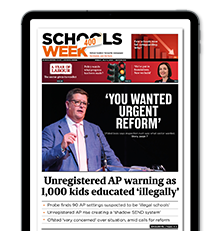School uniform is now costing secondary school parents £400 per year on average and still includes multiple branded items, according to a poll suggesting new government rules have had limited impact.
Statutory guidance came into force last September to ensure “the cost of school uniforms is reasonable and secures the best value for money”. It included new rules on branded items and affordability.
But a poll of 2,000 parents by The Children’s Society in May found total costs had actually risen.
Parents of secondary pupils pay on average £422 per year for uniform. At primary, the cost is £287 on average.
Below a quarter believed their school uniform policy had reduced the number of branded items.
Labour MP Mike Amesbury, who introduced the private member’s bill, said it appeared the new rules “aren’t clear enough so can be interpreted differently by schools, or the message isn’t getting through.
“I would urge the Department for Education to do more so schools make these important changes”.
Some schools have up to 7 branded items
In the guidance, schools are also asked to keep branded items “to a minimum”, including for PE kits.
The poll shows the average pupil was expected to have three branded items, while 29 per cent of secondary pupils were required to own four to five branded items.
Another 13 per cent of secondary pupils were expected to own between six and seven branded items.
Under the DfE’s own guidance, branded items are not just those with logos, but any item of clothing “with distinctive characteristics which make it unique to the school or trust”.
Schools are told to think about the “total cost of their school uniform” and that it is “not enough to consider everyday classroom wear”, under DfE’s advice.
The Children’s Society’s poll also revealed secondary school pupils’ parents were paying £75 on average a year for coats and bags, £63 for PE trainers and £62 for school shoes.
This was followed by blazers at £46, skirts and dresses at £46, and jumpers and ties at £40.
Mark Russell, the charity’s chief executive, described the figures as “alarming. With inflation and the cost of living eating into family budgets, we are disappointed that the affordability of school uniforms remains a significant financial burden for many families,” he said.
Schools not signposting parents to second-hand uniforms
Schools were expected to review policies to ensure they were compliant with the guidance by September last year. But nearly half (45 per cent) of parents reported that policies had not been updated.
While the charity acknowledged some schools may have already been compliant, only 30 per cent of parents reported that an up-to-date policy was available on the school website.
Schools are also told to ensure arrangements are in place so second-hand uniforms are available, such as through “periodic” sales or swap shops.
Only 26 per cent of parents said the school signposted them to such initiatives.
However, the charity did not release a full breakdown of their findings, so it is not known how many parents said schools had not signposted them to initiatives.
Last year, The Children’s Society estimated the average cost of school uniforms to be £315 per primary pupil and £337 per secondary pupil.
But it said this year’s figures were not comparable due to a change in questions asked of parents, as well as inflation, which now sits at 8.7 per cent.
Poorer children punished for breaching uniform guidance
Schools must “have regard” to the document when developing and implementing uniform policies.
The guidance states: “If a distinction can be made between those who can afford it and those who cannot, this can reduce the benefits of a uniform and has the potential to negatively impact attendance, access and participation, and lead to bullying.”
Where suspected financial hardship resulted in “non-compliance” with a school’s uniform policy, the guidance states schools would be expected “to take a mindful and considerate approach to resolve the situation”.
But the charity’s findings show 22 per cent of parents reported their child had been given a detention for breaching uniform policies due to being unable to afford correct uniform.
One in eight (12 per cent) of parents said their child had been placed in isolation for the same breach.
And 7 per cent said their child had been excluded for wearing the wrong clothing or shoes.
Schools minister Nick Gibb has previously said that the guidance was published “rather than subsidising expensive uniform policies with financial assistance”.
Though no government funding is allocated for supporting low-income families with the cost, “schools may offer additional support in cases of financial hardship”.
In a parliamentary written response to Amesbury last month, Gibb said the DfE had only received three complaints about school compliance with the statutory guidance.
A spokesperson for the DfE said: “We will continue to work with responsible bodies and schools to ensure the guidance is followed and uniform policies are reasonable.”
















“Gibb said the DfE had only received three complaints about school compliance with the statutory guidance.”
A disingenuous response. Complaints about schools go to schools and their governing boards. The DfE only gets involved if the complaint is that the school hasn’t handled the complaint properly.